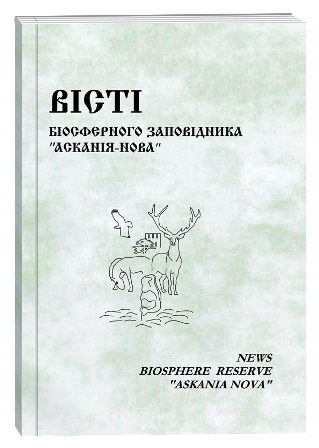FEATURES OF THE BIOTOPIC DISTRIBUTION OF SEPARATE SPECIES OF LAND MOLLUSKS IN DIFFERENT FUNCTIONAL ZONES OF URBOECOSYSTEM OF MELITOPOL
DOI:
https://doi.org/10.53904/1682-2374/2019-21/73Keywords:
Functional zones, mollusk fauna, ecological condition, biodiagnostic, urban ecosystem, spatio-temporal dynamicsAbstract
The work is devoted to the study of the terrestrial malacofauna, which were carried out for two years (spring 2017 – spring 2019) in different functional zones of the urban Melitopol ecosystem (the area of the transport highway, the territory of the industrial object, residential area, recreation area). In the studied biotopes 5 species of terrestrial mollusks were identified: Xeropicta derbentina (Krynicki 1836), Brephulopsis cylindrica (Menke, 1828), Monacha fruticola (Krynicki, 1833), Helix albescens (Rossmässler, 1839), Xeropicta krynickii (Krynicki 1833). Most of the representatives of the mollusk fauna were studied in the field.
It has been revealed, that land mollusks can be considered as promising objects of biodiagnostics of the ecological state of soils of anthropogenically transformed urban ecosystems, and also act as important agents of climate change. In addition, it is important to assess the effects of colonization of adventitious species of land mollusks for native biocenoses.
It has been established, that the land malacofauna of the Melitopol urban ecosystem is characterized by high numbers and small diversity. Adventive species predominate – X. derbentina, B. cylindrica, M. fruticola. Despite the fact that the latter species was considered to be endemic to the Crimea, it was well adapted to the urbanized biotopes in the south of Zaporozhye region. It was determined that for biodiagnostics of the state of anthropogenically disturbed biotopes, it is advisable to use the patterns of the spatio-temporal dynamics of the distribution of communities of terrestrial mollusks.
References
Adamova V. V. Peculiarities of adaptation of populations of adventitious species of terrestrial mollusks in the conditions of the south of the Central Russian Upland: Author. dis. for the degree of candidate. biol. Sciences: 03.00.16. Moscow, 2019. 24 p. (in Russian)
Gural-Sverlova N. V. The dependence of the size, shape and color of the shells in the populations of the Austrian CEPAEA VINDOBONENSIS (GASTROPODA, PULMONATA, HELICIDAE) from different regions of Ukraine. Natural almanac. 2013. Vol. 19. Р. 75–82. (in Russian)
Gural-Sverlova N. V., Gural R. I. Identifier of land mollusks of Ukraine. Lviv: State Natural History Museum of the National Academy of Sciences of Ukraine, 2012. 216 p. (in Ukrainian)
Kramarenko S. S. Formation of patterns of spatio-temporal variability of terrestrial mollusks: a multiscale approach: dis. ... Dr. Biol. Sciences: 03.00.08 / Nikolaev. nat. agrarian un-t. Nikolaev, 2014. 484 р. (in Russian)
Zhukov O. V. An ecomorphic analysis of consortia of soil animals. Dnipro : Svidler A. L., 2009. 239 p. (in Ukrainian)
Yorkina N. V. Impact of technogenic pollution of urban environment on vitality indicators of urban biota (Mollusk fauna, soil mesofauna, epiphytic lichens). Moscow University Biological Sciences Bulletin. 2016. Vol. 71 (3). P. 177–183.







